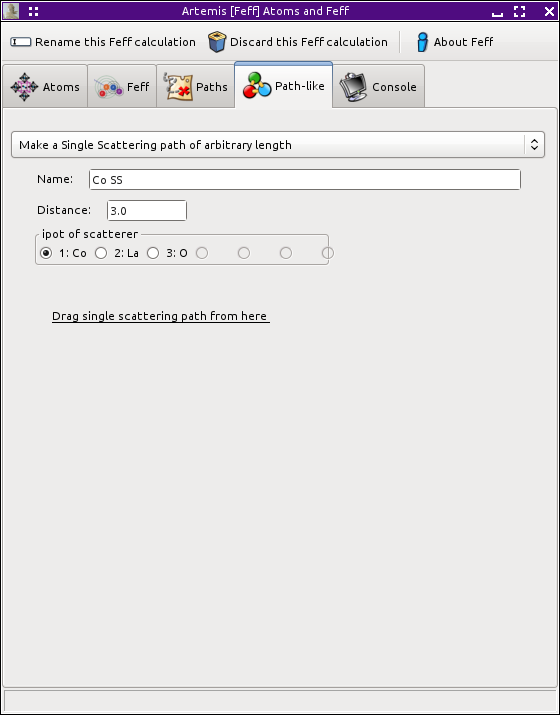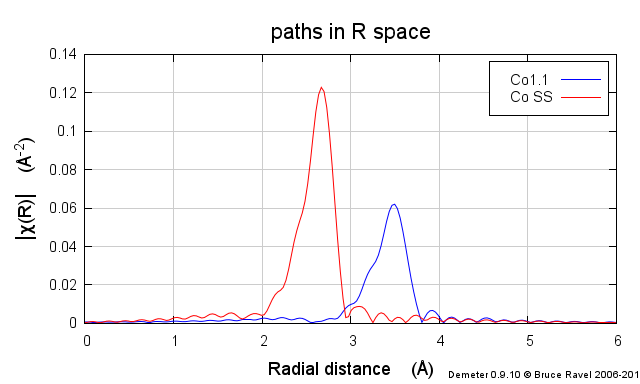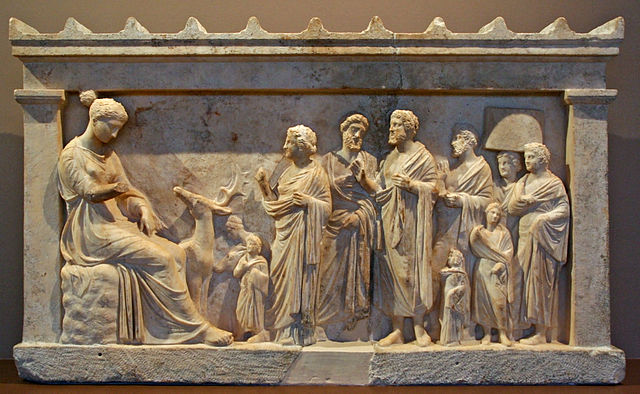4.4. The Path-like tab¶
One of the powerful features in ARTEMIS is the ability to define “path-like” objects. A path-like object is one which can be treated like a normal path from FEFF. It can be used in a fit and it can be plotted. It is not, however, the result of a normal FEFF calculation. Instead, FEFF has been run in some special way to generate a theoretical χ(k) spectrum for something different from all the items listed on the Paths tab.
ARTEMIS defines a number of kinds of path-like objects. Controls for generating these things are divided into different pages accessible by the menu at the top of the Path-like tab. The first item in that menu is for defining SSPaths.
4.4.1. Single Scattering Paths¶
The concept of a “Single Scattering Path” (or “SSPath”) is that it uses the potentials from a FEFF calculation to compute the single scattering contribution from an atom that exists in that FEFF calculation but at a distance not represented in the list of cartesian coordinates.
In the example shown, a FEFF calculation has been run on LaCoO3, a trigonal perovskite-like material with 6 oxygen scatterers at 1.93 Å, 8 La scatterers at 3.28 Å or 3.34 Å, and 6 Co scatterers at 3.83 Å.
Suppose we had some reason to wonder what a Co scatterer at a distance of 3 Å would look like in a fit. (For example, we might suspect that some phase segregation happened during synthesis, resulting in some CoO.) In that case, the distance on the SSPath page would be set to 3.0 Å and the Co scatterer would be selected from the group of radio buttons. This group of radio buttons corresponds to the list of unique potentials in the input data for FEFF.
The method for associating this SSPath with data will be explained in the next chapter. For now, we simply look at Fig. 4.11 to compare the normal Co scatterer at 3.83 Å (blue) with the SSPath computed at 3 Å (red).
Use of SSPath for modeling scatterers at such a long distance is much superior to using a quick first shell theory. The advantage of this approach is that it uses well constructed scattering potentials – i.e. potentials from a real structure – to make the special path. Using the quick first shell technique on a path this long results in poorly constructed potentials. This is explained in detail in the extended discussions chapter.
The SSPath is discussed in
- B. Ravel. Muffin-tin potentials in EXAFS analysis. Journal of Synchrotron Radiation, 22(5):1258–1262, Sep 2015. doi:10.1107/S1600577515013521.
4.4.2. FSPaths¶
Model the effect of variable forward scattering angle in nearly collinear multiple scattering paths.
Todo
FSPaths have not yet been implemented.
4.4.3. Histogram paths¶
Todo
Document the histogram system.
DEMETER is copyright © 2009-2016 Bruce Ravel – This document is copyright © 2016 Bruce Ravel
This document is licensed under The Creative Commons Attribution-ShareAlike License.
If DEMETER and this document are useful to you, please consider supporting The Creative Commons.


